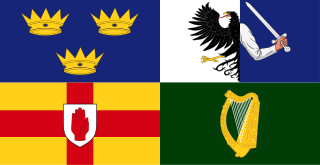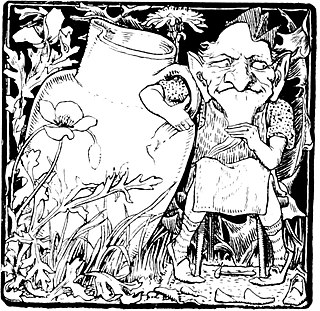
A banshee is a female spirit in Irish folklore who heralds the death of a family member, usually by screaming, wailing, shrieking, or keening. Her name is connected to the mythologically important tumuli or "mounds" that dot the Irish countryside, which are known as síde in Old Irish.

Aos sí is the Irish name for a supernatural race in Celtic mythology – daoine sìth in Scottish Gaelic – comparable to fairies or elves. They are said to descend from the Tuatha Dé Danann, meaning the 'People of Danu', depending on the Abrahamic or pagan tradition.

A fairy tale is a short story that belongs to the folklore genre. Such stories typically feature magic, enchantments, and mythical or fanciful beings. In most cultures, there is no clear line separating myth from folk or fairy tale; all these together form the literature of preliterate societies. Fairy tales may be distinguished from other folk narratives such as legends and explicit moral tales, including beast fables. Prevalent elements include dragons, dwarfs, elves, fairies, giants, gnomes, goblins, griffins, merfolk, monsters, talking animals, trolls, unicorns, witches, wizards, magic, and enchantments.

A fairy is a type of mythical being or legendary creature, generally described as anthropomorphic, found in the folklore of multiple European cultures, a form of spirit, often with metaphysical, supernatural, or preternatural qualities.

A leprechaun is a diminutive supernatural being in Irish folklore, classed by some as a type of solitary fairy. They are usually depicted as little bearded men, wearing a coat and hat, who partake in mischief. In later times, they have been depicted as shoe-makers who have a hidden pot of gold at the end of the rainbow.
A trow is a malignant or mischievous fairy or spirit in the folkloric traditions of the Orkney and Shetland islands. Trows may be regarded as monstrous giants at times, or quite the opposite, short-statured fairies dressed in grey.

A pixie is a mythical creature of British folklore. Pixies are speculated to be particularly concentrated in the high moorland areas around Devon and Cornwall, suggesting some Celtic origin for the belief and name. However, the word 'pixie' also appears in Dorset, Somerset and to a lesser extent in Sussex, Wiltshire and Hampshire.

The púca, pucapwca, pooka, phouka, puck is a creature of Celtic, English, and Channel Islands folklore. Considered to be bringers both of good and bad fortune, they could help or hinder rural and marine communities. Púcaí can have dark or white fur or hair. The creatures were said to be shape-changers that could take the appearance of horses, goats, cats, dogs, and hares. They may also take a human form, which includes various animal features, such as ears or a tail.
Fairies, particularly those of Irish, English, Scottish and Welsh folklore, have been classified in a variety of ways. Classifications – which most often come from scholarly analysis, and may not always accurately reflect local traditions – typically focus on behavior or physical characteristics.

Merrow is a mermaid or merman in Irish folklore. The term is anglicised from the Irish word murúch.

The Dullahan, also called Colainn Gan Cheann, is a type of legendary creature in Irish folklore. He is depicted as a headless rider, on a black horse, who carries his own head held high in his hand or under his arm.

Irish folklore refers to the folktales, balladry, music, dance and mythology of Ireland. It is the study and appreciation of how people lived.

Thomas Crofton Croker was an Irish antiquary, best known for his Fairy Legends and Traditions of the South of Ireland (1825–1828), and who also showed considerable interest in Irish song and music.

A gancanagh is a male fairy from the mythology of Northern Ireland, known for seducing women.

The clurichaun or clúrachán is a mischievous fairy in Irish folklore known for his great love of drinking and a tendency to haunt breweries, pubs and wine cellars. He is related to the leprechaun and has sometimes been conflated with him as a shoemaker and a guardian of hidden treasure. This has led some folklorists to suppose that the clurichaun is merely a leprechaun on a drinking spree, while others regard them as regional variations of the same being. Like the leprechaun, the clurichaun is a solitary fairy, encountered alone rather than in groups, as distinct from the trooping fairies.

A lutin is a type of hobgoblin in French folklore and fairy tales. Female lutins are called lutines.

In Irish mythology, the fear gorta is a phantom of hunger resembling an emaciated human.

Fairy forts are the remains of stone circles, ringforts, hillforts, or other circular prehistoric dwellings in Ireland. From (possibly) the late Iron Age to early Christian times, the island's occupants built circular structures with earth banks or ditches. These were sometimes topped with wooden palisades and wooden framed buildings. As the dwellings were not durable, only vague circular marks often remained in the landscape. The remains of these structures, in conjunction with the vegetation around them, are associated with local traditions and folklore, perhaps involving fairies or other supposed supernatural entities, who would "defend" the structures from destruction by builders or farmers.

Castle Hackett is a 13th-century tower house at the base of Knockma hill, 10 kilometres (6 mi) south-west of Tuam, County Galway, Ireland.














